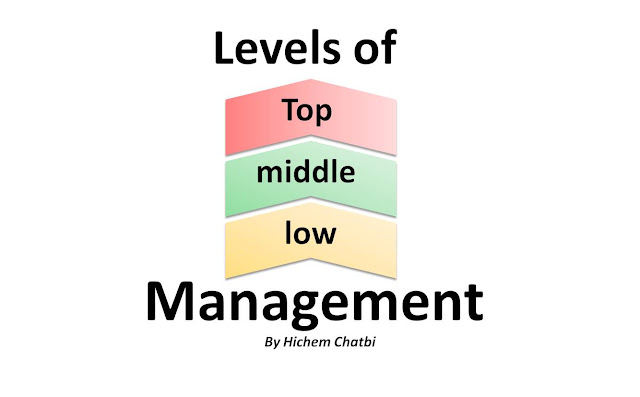levels of management
Levels of management refer to the administrative divisions, and determines a chain of command, the amount of authority and status of differents managerial positions, as as the size of business increases, the number of management levels increases and become more complex.
The levels of management can be classified into three broad
categories (Top level – middle level – low level ).
1) Top-level of management :
Top-Level Management, it is the first source of authority and
it manages the organisation goals and policies, it's consists of President and
the Vice President, Board of Directors, the Chief Executive Officer (CEO), the
Chief Financial Officer (CFO) and the Chief Operating Officer (COO), They
coordinate services and devotes time on planning.
The role of top-level management :
the top-level management is responsible towards the
shareholders for the company performance, and maintaining a
contact/communication with The external environment of the company.
the top-level management it's responsible for laying the
objectives and policies of the company, and preparing the strategic plans and
policies for the company.it responsible also for the controls and coordinates
the activities of all the departments, and making instructions for preparation
of department budgets, procedures, schedules.
the top level of management is also responsible for appointing
the executive for the middle level of management.
2) The middle level of management :
Middle-level Management referred to as the executory level,
made up of the departmental managers and branch manager, they are subordinates
of the top-level management but are responsible for the organization and the direction of the low-level management,
In a small organization, there is only one layer of middle
level of management but in big enterprises, there may be senior and junior
middle-level management.
The role of top-level management :
executing the plans according to policies and directives
laid down by the top-level management, and making plans for the sub-units of
the organization.
organizing the division or departmental activities,
motivating and training of lower-level junior managers to improve their
efficiency.
they are responsible for the communication between the top
level and the lower level by explaining the policies from top-level management
to lower level and sends important reports and data from low level to top-level
management.
3) Low level of management :
Lower Level of Management or supervisory or operative level,
It might be called the lower level, but it is very important in the organization, It consists of supervisors, foreman, section officers,
superintendent, They are in direct contact with the workers.
The role of top-level management :
They guide workers for activities and assigning them of
their daily weekly monthly ... tasks.
they are responsible for solving and communicate problems of
workers to the higher levels.
providing training and motivating to the workers.
They are also entrusted with the responsibility of
maintaining good relationships and ensure discipline in the enterprise. in the
organization.
responsible for necessary materials, machines, tools of
production.
transferring periodical reports to the higher levels about
the performance of the workers.
In the end, we say that all levels of management are
complementary to each other, and each level has an active role in the
organization.
If you have questions, criticism, or additions ...leave us a comment !!
thank you



Comments
Post a Comment